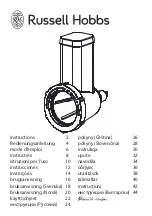
28
GB
Removing and fitting the oven door:
1.Open the door
2.Make the hinge clamps of the oven door rotate
backwards completely (see photo)
3.Close the door until the clamps stop (the door will
remain open for 40° approx.) (see photo)
40°
4.Press the two buttons on the upper profile and
extract the profile (see photo)
5.Remove the glass sheet and do the cleaning as
indicated in chapter: "Care and maintenance".
6.Replace the glass.
WARNING! Oven must not be operated with inner
door glass removed!
WARNING! When reassembling the inner door
glass insert the glass panel correctly so that the
text written on the panel is not reversed and
can be easily legible.
7.Replace the profile, a click will indicate that the
part is positioned correctly.
8.Open the door completely.
9.Close the supports (see photo).
10.Now the door can be completely closed and the
oven can be started for normal use.
Catalitic Cleaning*
In some models, the most exposed internal vertical
sides of the oven are coated with porous enamel,
which is called catalytic enamel. When heated, this
enamel destroys fat particles given off by the food.
This "oxidation" of the fat particles occurs when the
temperature of the sides exceeds 170°C. The porous
quality of the catalytic enamel increases the surface
area where the exchange vital to the oxidation of the
fats takes place.
If there is still grime on the catalytic surfaces after
the cooking programme has ended, leave the empty
oven on with the door shut, turning the temperature
adjustment knob to its maximum setting. Leave the
oven like this for a period of time between 60 and 90
minutes, according to how much dirt was left inside.
The cleaning process for more stubborn food residues
may be quickened by using hot water and a soft brush.
*
Only available in certain models.
















































